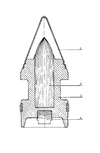AP = armour-piecing tracer = a solid projectile (shot), which commonly have a relatively blunt ogival (2 calibre radius head [2 CRH]) nose and a short body.
AP-T = armour-piecing tracer = as above with a tracer.

57 mm (6 Pdr.) AP-T Round Sectional Diagram
APHE = armour-piecing high explosive = as per AP, but with a hollow projectile (shell), which includes a base fuze and small high explosive bursting charge. The APHE designation isn't really used, with just AP shell (not shot) being used.
APHE-T = armour-piecing high explosive tracer = as per APHE, but includes a tracer. As per APHE, the APHE-T designation isn't really used.
APC = armour-piecing capped = as per AP, but with a blunt penetrating cap of the projectile, which acts a shock buffer on impact.
APC-T = armour-piecing capped tracer = as per APC, but with a tracer.

57 mm (6 Pdr.) APC-T Round Sectional Diagram
APCHE = armour-piecing capped high explosive = as per APHE, but capped as per APC. The APCHE designation isn't really used, with just APC shell (not shot) being used.
APCHE-T = armour-piecing capped high explosive tracer = as per APCHE, but with a tracer. The APCHE-T designation isn't really used.
APBC = armour-piecing ballistic-capped = an AP projectile with a thin metal pointed cap, which improves aerodynamics (lowers drag). The projectile nose under the cap is often blunt/flat. High explosive versions would be APBCHE, but the designation isn't really used.
APBC-T = armour-piecing ballistic-capped = as per APBC = but with a tracer. High explosive versions would be APBCHE-T, but the designation isn't really used.
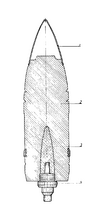
76 mm 53-BR-350B APBCHE-T Projectile Sectional Diagram
APCBC = armour-piecing capped ballistic-capped = an APC, with a ballistic cap. High explosive versions would be APCBCHE, but the designation isn't really used.
APCBC-T = armour-piecing capped ballistic-capped tracer = an APCBC, with a tracer. High explosive versions would be APCBCHE-T, but the designation isn't really used.

57 mm (6 Pdr.) APCBC-T Round Sectional Diagram
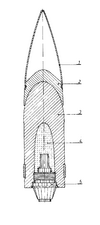
76 mm M62A1 APCBCHE-T Projectile Sectional Diagram
APCR = armour-piecing composite rigid = a British term for a composite projectile, which houses a high density penetrating core within a non-discarding lightweight outer assembly (sheath). Later known as HVAP, high velocity armour piecing. Normally tracered, so APCR-T and HVAP-T.

76 mm M93A1 HVAP (APCR) Round Sectional Diagram
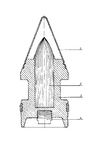
76 mm 53-BR-354P HVAP (APCR, Arrow) Projectile Sectional Diagram
APCNR = armour-piecing composite non-rigid = similar to APCR, but with a primary projetile that has a smaller diameter body, which has deformable areas. The latter area, such as the forward bore-riding area (bourrelet) and rear skirt, are squeezed down to a smaller calibre body when fired down a squeeze bore (German) or device attached to the muzzle (British).
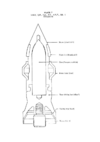
40 mm (2 Pdr.) AP-T (APCNR-T) Projectile Sectional Diagram
Concrete penetrating = a hollow high explosive filled shell, which commonly has a reinforced body (thicker side walls), often a solid flat tip, and a rear (base) mounted delay fuze.
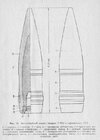
122 mm 53-G-471 Anti-Concrete Projectile Diagrams










